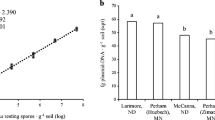Abstract
The efficacy of metam sodium (MS) for controlling Verticillium wilt of potato was evaluated in two field experiments conducted in a sandy soil, heavily infested withVerticillium dahliae, and previously treated with MS. Compared to control plots where AUDPC value was 3141 (in 1999) and stem infection was 71.2% (in 2000), in plots treated with 600 L MS/ha AUDPC values were reduced by 57% to 80%, and stem infection was reduced by 49–54%. The incidence of infected dry stems, evaluated at the end of each season, was significantly reduced by all MS treatments, especially by 900 L/ha applied to a 60-cm depth (1999). Disease incidence in daughter tubers was also significantly reduced by all MS treatments. Yields obtained with 600 L/ha MS applied to a 30-cm depth were 32% and 21% higher than in the control in 1999 and 2000, respectively. In plots treated with 600 L/ha MS applied to a 60-cm depth yields were 17% and 28% higher than in the control in 1999 and 2000, respectively. With 900 L/ha MS applied to a 60-cm depth, yield was 21% higher than in the control in 1999. The yield of the low MS dose (300 L/ha), applied only in 2000, was not significantly different from the control. The differences in yield were due to the greater percentage of tubers larger than 45 mm. Yield reduction was highly correlated with disease severity expressed as AUDPC (in 1999 experiment). The net income in the 600 L MS/ha treatments was higher than in the control in both experiments. No indication of enhanced biodegradation was observed in the present study.
Resumen
La eficacia del metam sodio (MS) para controlar la marchitez causada por Verticillium en plantas de papa, fue evaluada en dos experimentos de campo realizados en suelo arenoso fuertemente infestado conVerticillium dahliae y previamente tratado con MS. En comparación con las parcelas testigo donde los valores AUDPC fueron de 3141 (en 1999) y la infección al tallo fue de 71.2% (en 2000), en parcelas tratadas con 600 litros (L) de MS/ha, los valores AUDPC se redujeron en 57% a 80% y la infección al tallo se redujo en 49% a 54%. La incidencia de tallos infectados secos, evaluados al final de cada campaña fue reducida significativamente con todos los tratamientos de MS, especialmente cuando se aplicó 900 L/ha a profundidad de suelo de 60 cm (1999). La incidencia de la enfermedad en los tubérculos hijos también fue reducida significativamente con todos los tratamientos de MS. Los rendimientos obtenidos con 600 L de MS/ha aplicados a 30 cm de profundidad fueron 32% y 21% más altos que en el testigo en 1999 y 2000 respectivamente. En parcelas tratadas con 600 L/ha de MS aplicado a 60cm de profundidad, los rendimientos fueron 17% y 28% más altos que en el testigo en 1999 y 2000 respectivamente. Con 900 L/ha de MS aplicados a 60 cm de profundidad, el rendimiento fue 21% más alto que en el testigo en 1999. El rendimiento a dosis baja de MS (300 L/ha) aplicado solamente en el 2000, no fue significativamente diferente del testigo. Las diferencias en rendimiento se debieron a la presencia de un mayor porcentaje de tubérculos de más de 45 mm. La reducción del rendimiento fue mayormente correlacionada con la severidad de la enfermedad expresada como AUDPC (en el experimento de 1999). El ingreso neto en los tratamientos de 600 L de MS/ha fue mayor que en el testigo, en ambos experimentos. En el presente estudio no se observó ninguna indicación de intensificación de la biodegradación.
Similar content being viewed by others
Literature cited
Barkdoll AW, and JR Davis. 1992. Distribution ofColletotrichum coccodes in Idaho and variation in pathogenicity on potato. Plant Dis 76:131–135.
Ben-Yephet Y, E Siti, and Z Frank. 1983. Control by metam-sodium in loessial soil and effect on potato tuber yields. Plant Dis 67:1223–1225.
Bowers JH, ST Nameth, RM Riedel, and RC Rowe. 1996. Infection and colonization of potato roots byVerticillium dahliae as affected byPratylenchus penetrans andP. crenatus. Phytopathology 86:614–621.
Davis JR, WH Loescher, MW Hammond, and RE Thornton. 1983. Response of Russet Burbank potatoes to soil fumigation and nitrogen fertilizers. Am Potato J 63:71–79.
Di Primo P, A Gamliel, M Austerweil, B Steiner, M Beniches, I Peretz-Alon, and J Katan. 2003. Accelerated degradation of metamsodium and dazomet in soil: characterization and consequences for pathogen control. Crop Prot 22:635–646.
Krikun J, and ZR Frank. 1982. Metham sodium applied by sprinkler irrigation to control pod rot and Verticillium wilt of peanut. Plant Dis 66:128–130.
Krikun J, and D Orion. 1979. Verticillium wilt of potato: importance and control. Phytoparasitica 7:107–116.
Racke KD. 1990. Pesticides in the soil microbial ecosystem.In: KD Racke and JR Coats (eds), Enhanced Biodegradation of Pesticides in the Environment. American Chemical Society, Washington, DC. pp 1–12.
Rowe RC, JR Davis, ML Powelson, and DI Rouse. 1987. Potato early dying: causal agents and management strategies. Plant Dis 71:482–489.
Rowe RC, and ML Powelson. 2002. Potato early dying: management challenges in a changing production environment. Plant Dis 86:1184–1193.
Saeed IAM, DI Rouse, JM Harkin, and KP Smith. 1997. Effects of soil water content and soil temperature on efficacy of methamsodium againstVerticillium dahliae. Plant Dis 81:773–776.
Shaner G, and RE Finney. 1977. The effect of nitrogen fertilization on the expression of slow-mildewing resistance in Knox wheat. Phytopathology 67:1051–1056.
Smelt JH, SJH Crum, and W Teunissen. 1989. Accelerated transformation of the fumigant methyl isothiocaynate in soil after repeated application of metham sodium. J Environ Sci Health 24:437–455. 33:3–11.
Tsror (Lahkim) L, O Erlich, and M Hazanovsky. 1999. The effect ofColletotrichum coccodes (Wallr.) on potato yield, tuber quality and stem colonization during spring and autumn. Plant Dis 83:566–568.
Author information
Authors and Affiliations
Corresponding author
Rights and permissions
About this article
Cite this article
Tsror (Lahkim), L., Shlevin, E. & Peretz-Alon, I. Efficacy of metam sodium for controllingVerticillium dahliae prior to potato production in sandy soils. Am. J. Pot Res 82, 419–423 (2005). https://doi.org/10.1007/BF02871972
Accepted:
Issue Date:
DOI: https://doi.org/10.1007/BF02871972




